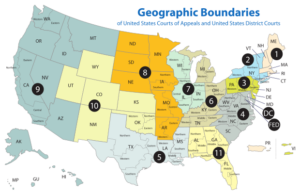The United States federal court system is a hierarchical structure consisting of three levels: the district courts, the courts of appeals, and the Supreme Court. District courts are trial-level courts who have jurisdiction over a wide range of federal cases, including criminal cases, civil cases involving federal law, and cases involving federal agencies. The courts of appeals are intermediate appellate courts, who hear appeals from the district courts and other federal agencies within their geographic jurisdiction. The Supreme Court is the highest court in the United States, and has the final say on all cases involving federal law and the United States Constitution.
 The federal court system was established by the Constitution, which gives Congress the power to create and regulate federal courts. Our first federal courts were created by the Judiciary Act of 1789, which only established district courts and the Supreme Court. The Act also created the Office of the Attorney General and provided for the appointment of federal judges by the President, with the advice and consent of the Senate.
The federal court system was established by the Constitution, which gives Congress the power to create and regulate federal courts. Our first federal courts were created by the Judiciary Act of 1789, which only established district courts and the Supreme Court. The Act also created the Office of the Attorney General and provided for the appointment of federal judges by the President, with the advice and consent of the Senate.
Over time, the federal court system has evolved and expanded to meet our country’s changing needs. The number of federal district courts and judges has increased while new courts of appeals have been established.
The Second Circuit (in case citations, “2d Cir.”) has appellate jurisdiction over the district courts in the following federal judicial districts:
- District of Connecticut
- Eastern District of New York
- Northern District of New York
- Southern District of New York
- Western District of New York
- District of Vermont
It is headquartered in Lower Manhattan. Because the Second Circuit includes New York City, it has long been one of the largest and most influential American federal appellate courts, especially in matters of contract law, securities law, antitrust law, and surprisingly enough, gun law. Last term, on appeal from the Second Circuit, the Supreme Court left in place a ruling which held that states remained free to ban guns in sensitive places, providing a few examples: schools, government buildings, legislative assemblies, polling places and courthouses. But Justice Thomas, writing for the majority, cautioned that “expanding the category of ‘sensitive places’ simply to all places of public congregation that are not isolated from law enforcement defines the category of ‘sensitive places’ far too broadly.”
The Second Circuit continues to play a key role in shaping the law in the Northeast United States and beyond.